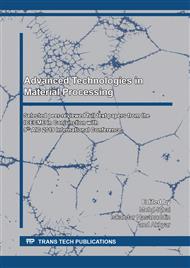[1]
C. Kelly. D. L. Lixandr~ao, F. F. Ferreira, Polypropylene and tire powder composite for use in automotive industry, Heliyon. 5 (2019) e02405.
DOI: 10.1016/j.heliyon.2019.e02405
Google Scholar
[2]
A. Gargano, K. Pingkarawat, M. Blacklock, V. Pickerd, A. P. Mouritz, Comparative assessment of the explosive blast performance of carbon and glass fibre-polymer composites used in naval ship structures, Composite Structures. 171 (2017) 306-316.
DOI: 10.1016/j.compstruct.2017.03.041
Google Scholar
[3]
Nazaruddin, A. Akram, I. Hasanuddin, M. Iqbal, R Kurniawan, R. Putra, Mechanical properties of glass fiber reinforced polyester resin for use as the wall of the Acehnese boat Thep-Thep, IOP Conference Series: Materials Science and Engineering. 523 (2019) 012080.
DOI: 10.1088/1757-899x/523/1/012080
Google Scholar
[4]
J. Marsh, Composites in commercial jets, Reinforced Plastics, 59(4) (2015) 190-193.
DOI: 10.1016/j.repl.2015.06.001
Google Scholar
[5]
J. Huang, Fabrication and properties of carbon fibers, Materials. 2(4) (2009) 2369–403.
Google Scholar
[6]
M. Iqbal, A. Akram, M. Tadjuddin, Thrust force in drilling of meranti particle board. International Journal of Applied Engineering Research (IJAER), 10(95) (2015) 16-20.
Google Scholar
[7]
M. Iqbal, M. Konneh, M.H. Ani, K. A. Abdallah, M.F. Binting, Cutting temperature in high speed milling of silicon carbide using diamond coated tool, International Journal of Mechanical And Production Engineering. 3(4) (2015) 62-66.
Google Scholar
[8]
Z. Fuadi, T. Takeno, K. Adachi, M. Tadjuddin, M. Iqbal, Friction and wear of amorphous carbon coated stainless steel under palm methyl ester contained diesel oil, ARPN Journal of Engineering and Applied Sciences. 11(7) (2016).
Google Scholar
[9]
M. Baraheni, A. Tabatabaeian, S. Amini, A.R. Ghasemi, Parametric analysis of delamination in GFRP composite profiles by performing rotary ultrasonic drilling approach: Experimental and statistical study, Composites Part B. 172 (2019) 612–620.
DOI: 10.1016/j.compositesb.2019.05.057
Google Scholar
[10]
J. F. Perez, J.L. Cantero, J.D. Alvarez, M. H. Miguelez, Influence of cutting parameters on tool wear and hole quality in composite aerospace components drilling, Composite Structures. 178 (2017) 157–161.
DOI: 10.1016/j.compstruct.2017.06.043
Google Scholar
[11]
U. A. Khashaba, I. A. El-Sonbaty, I. A. Selmy, A. A. Megahed, Machinability analysis in drilling woven GFR/epoxy composites: Part I-Effect of machining parameters, Compos A Appl Sci Manuf. 41(3) (2010) 391–400.
DOI: 10.1016/j.compositesa.2009.11.006
Google Scholar
[12]
S. Huzni, M. Ilfan, T. Sulaiman, S. Fonna, M. Ridha, AK Arifin, Finite element modeling of delamination process on composite laminate using cohesive elements, International Journal of Automotive and Mechanical Engineering. 7 (2013) 1023.
DOI: 10.15282/ijame.7.2012.18.0083
Google Scholar
[13]
J. Li, Y. C. Xia, Interfacial characteristics of an epoxy composite reinforced with phosphoric acid-functionalized Kevlar fibers, Mech Compos Mater. 46 (2010) 211-4.
DOI: 10.1007/s11029-010-9139-9
Google Scholar
[14]
MKFM. Paudzi, MF Abdullah, A Ali, Fatigue analysis of hybrid composites of kenaf/kevlar fibre reinforced epoxy composites, Jurnal Kejuruteraan. SI 1(7) (2018) 65-70.
Google Scholar
[15]
M. Iqbal, S. Bahri, A. Akram, Effect of cutting parameter on tool wear of HSS tool in drilling of Kevlar composite panel, IOP Conference Series: Materials Science and Engineering. 523 (2019) 012078.
DOI: 10.1088/1757-899x/523/1/012078
Google Scholar


